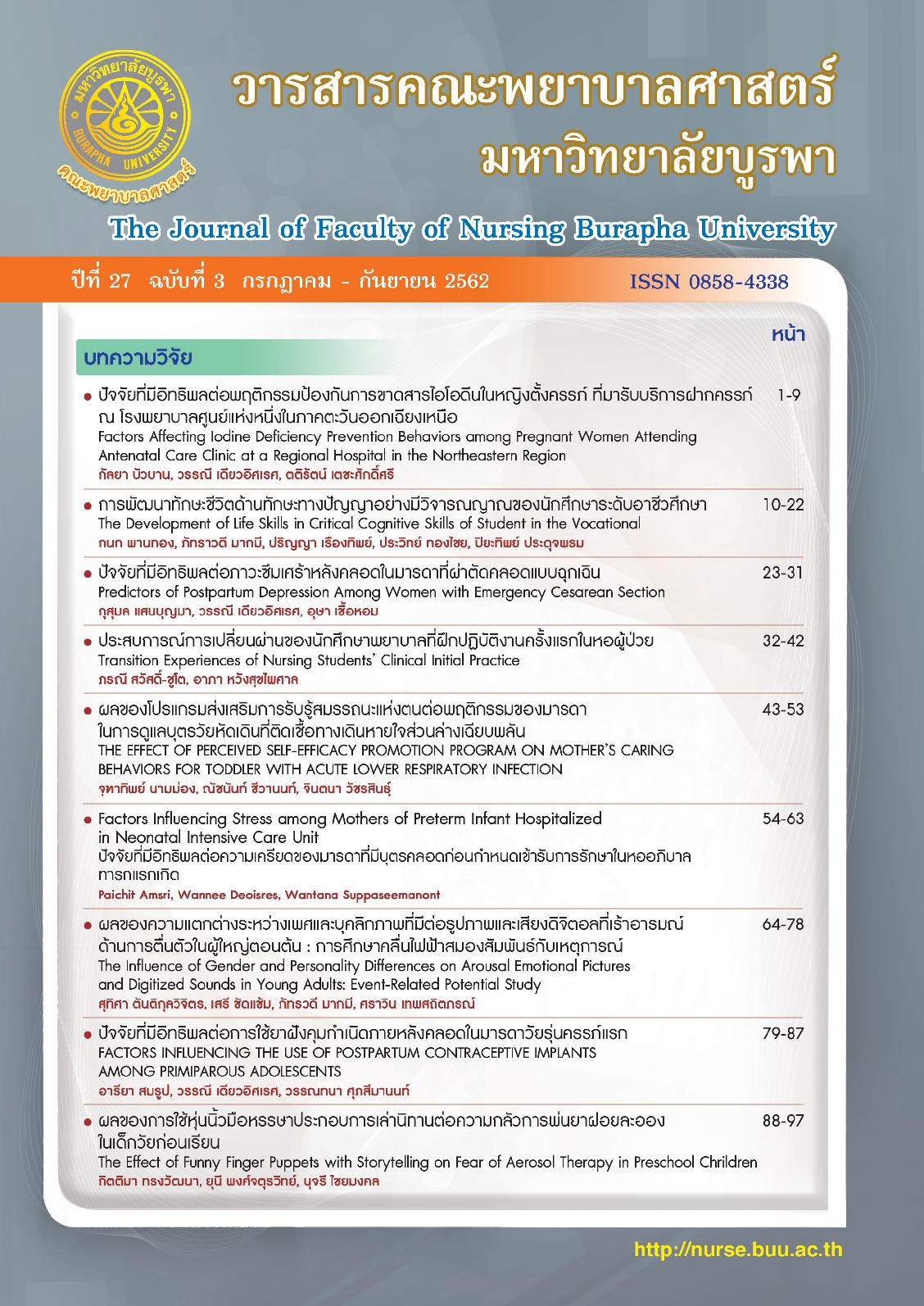ผลของความแตกต่างระหว่างเพศและบุคลิกภาพที่มีต่อรูปภาพและเสียงดิจิตอลที่เร้าอารมณ์ด้านการตื่นตัวในผู้ใหญ่ตอนต้น : การศึกษาคลื่นไฟฟ้าสมองสัมพันธ์กับเหตุการณ์
คำสำคัญ:
อารมณ์ด้านการตื่นตัว, บุคลิกภาพแบบเปิดเผย, บุคลิกภาพแบบกลาง ๆ, คลื่นไฟฟ้าสมองสัมพันธ์กับเหตุการณ์บทคัดย่อ
บทคัดย่อ
การวิจัยนี้มีวัตถุประสงค์เพื่อออกแบบกิจกรรมการทดลองมองรูปภาพและฟังเสียงดิจิทัลที่เร้าอารมณ์ด้านการตื่นตัวในผู้ใหญ่ตอนต้น ศึกษาคลื่นไฟฟ้าสมองสัมพันธ์กับเหตุการณ์ ขณะมองรูปภาพและฟังเสียงดิจิทัลที่เร้าอารมณ์ด้านการตื่นตัว จำแนกตามเพศและบุคลิกภาพ กลุ่มตัวอย่างเป็นนิสิต มหาวิทยาลัยบูรพา ปีการศึกษา 2560 จำนวน 80 คน แบ่งเป็นกลุ่มเพศชายและเพศหญิงที่มีบุคลิกภาพแบบเปิดเผย กลุ่มละ 20 คน และกลุ่มเพศชายและเพศหญิงที่มีบุคลิกภาพแบบกลาง ๆ กลุ่มละ 20 คน เครื่องมือที่ใช้ในการวิจัยประกอบด้วย กิจกรรมการทดลองมองรูปภาพและฟังเสียงดิจิทัลที่เร้าอารมณ์ด้านการตื่นตัว และเครื่องบันทึกคลื่นไฟฟ้าสมอง วิเคราะห์ข้อมูลด้วยสถิติ two-way ANOVA ผลการวิจัยพบว่า
1. กิจกรรมการทดลองมองรูปภาพและฟังเสียงดิจิทัลที่เร้าอารมณ์ด้านการตื่นตัวในผู้ใหญ่ตอนต้น ประกอบด้วย กิจกรรม 2 ชุด ชุดละ 12 สิ่งเร้า สิ่งเร้าละ 14.5 วินาที จำแนกตามลักษณะอารมณ์ คือ ลักษณะสงบและลักษณะตื่นเต้น
2. คลื่นไฟฟ้าสมองของผู้ใหญ่ตอนต้น ขณะมองรูปภาพและฟังเสียงดิจิทัลที่เร้าอารมณ์ด้านการตื่นตัว ลักษณะตื่นเต้น พบความแตกต่างทางเพศมีผลที่บริเวณเปลือกสมองส่วนหน้า (Frontal Lobe) ที่ตำแหน่ง FP1 อย่างมีนัยสำคัญทางสถิติที่ระดับ .05 และลักษณะสงบ พบความแตกต่างทางบุคลิกภาพมีผลที่บริเวณสมองกลีบท้ายทอย (Occipital Lobe) ที่ตำแหน่ง PO3 และบริเวณสมองกลีบขมับ (Temporal Lobe) ที่ตำแหน่ง P8
เอกสารอ้างอิง
Ahveninen, J., Huang, S., Ahlfors, S.P., Hämäläinen, M., Rossi, S., Sams, M., &
Jääskeläinen, I.P. (2016). Interacting parallel pathways associate sounds with
visual identity in auditory cortices. NeuroImage, 124, 858-868.
Aluja, A., Rossier, J., Blanch, Á., Blanco, E., Martí-Guiu, M., & Balada, F. (2015).
Personality effects and sex differences on the International Affective Picture System (IAPS): A Spanish and Swiss study. Personality and individual differences, 77, 143-148
Bradley, M.M., & Lang, P.J. (1994). Measuring emotion: The self-assessment manikin and the semantic differential. Journal of Behavior Therapy and Experimental Psychiatry, 25(1), 49-59.
Bradley, M.M., & Lang, P.J. (1999). Affective norms for English words (ANEW):
Instruction manual and affective ratings. Retrieved from https://www.uvm.rdu/ pdodds/teaching/courses/2009-08UVM-300/doc/others/everything/bradley1999a.pdf
Bradley, M. M., & Lang, P. J. (1999). The International affective digitized sounds (IADS): stimuli, instruction manual and affective ratings: NIMH Center for the study of emotion and attention. Journal of Behavioral Therapy and Experimental Psychiatry, 25(-), 49-59.
Bradley, M.M., & Lang, P.J. (2007). Affective Norms for English Text (ANET): Affective ratings of text and instruction manual. Technical Report. D-1. University of Florida: Gainesville, Florida.
Bradley, M.M., & Lang, P.J. (2007). The International Affective Digitized Sounds (IADS-2): Affective ratings of sounds and instruction manual. Tech. Rep. B-3. University of Florida: Gainesville, Florida,
Choi, Y., Lee, S., Choi, I., Jung, S., Park, Y., & Kim, C. (2015). International affective digitized sounds in Korea: A cross-cultural adaptation and validation study. Aacta Acustica United with Acustica, 101(1), 134-144.
DeYoung, C.G., Weisberg, Y.J., Quilty, L.C., & Peterson, J.B. (2013). Unifying the aspects of
the Big Five, the interpersonal circumplex, and trait affiliation. Journal of Personality, 81(5), 465475. doi: 10.1111/jopy.12020
Domes, G., Schulze, L., Bottger, M., Grossmann, A., Hauenstein, K., Wirtz, P. H., . . .
Herpertz, S. C. (2010). The neural correlates of sex differences in emotional reactivity
and emotion regulation. Hum Brain Mapp, 31(5), 758-769. doi: 10.1002/hbm.20903
Edmonds, W.A., & Kennedy, T.D. (2017). An applied reference Guide to Research Designs:
quantitative, qualitative, and mixed Methods. (2nd ed.). California: Sage
Publications.
Eysenck HJ. (1970). The structure of human personality. (3rd ed.). London: Methuen.
Gerdes, A., Wieser, M. J., Mühlberger, A., Weyers, P., Alpers, G. W., Plichta, M. M., Pauli, P. (2010). Brain activations to emotional pictures are differentially associated with valence and arousal ratings. Frontiers in Human Neuroscience, 4(175), 1-8.
Gerdes, A., Wieser, M.J., & Alpers, G.W. (2014). Emotional pictures and sounds: A review of multimodal interactions of emotion cues in multiple domains. Frontiers in Psychology, 5, 1351.
Han, S., Gao, X., Humphreys, G.W., & Ge, J. (2008). Neural processing of threat cues in social environments. Human Brain Mapping, 29(8), 945-957. doi: 10.1002/hbm.20439
Kravitz, D.J., Saleem, K.S., Baker, C.I., Ungerleider, L.G., & Mishkin, M. (2013). The ventral visual pathway: An expanded neural framework for the processing of object quality. Trends in Cognitive Sciences, 17(1), 26-49.
Lang, P., Bradley, M., Cuthbert, B., (2005). International Affective Picture System (IAPS):
Affective ratings of pictures and instruction manual. University of Florida: Gainsville, Florida.
Luo, P., Zheng, X., Chen, X., Li, Y., Wang, J., Deng, L., & Zheng, X. (2014). Sex differences in affective response to different intensity of emotionally negative stimuli: An event-related potentials study. Neuroscience Letters, 2014(578), 85-89.
Mendoza-Halliday, D., Torres, S., & Martinez-Trujillo, J. C. (2014). Sharp emergence of feature-selective sustained activity along the dorsal visual pathway. Nature Neuroscience, 17(9), 1255-1262.
Plichta, S.B., Kelvin, E.A., & Munro, B.H. (2013). Munro's statistical methods for health care research. New York: Wolters Kluwer Health/Lippincott Williams & Wilkins.
Phusuwan, T., Chadcham, S., Thepsatitporn, S. (2018). Development of the Thai Affective sound bank system. Research Methodology & Cognitive Science, 16(2), 126-144.
Rose, C.L, Murphy, L.B, Byard, L, Nikzad, K. (2002). The role of the big five personality factors in vigilance performance and workload. European Journal of Personality, 16(3), 185–200.
Schmidt, A., Beauducel, A., Brocke, B., & Strobe.l, A. (2004). Vigilance performance and extraversion reconsidered: some performance differences can indeed be induced. Personality and Individual Differences, 36(6), 1343–51
Shiota, M.N., & Kalat, J.W. (2012). Emotion (2nd ed.). Belmont: Wadsworth.
Sripornngam, T., Chadcham, S., Sudhasani., S. (2015). Development of the Thai Affective picture bank system. Research Methodology & Cognitive Science, 13(2), 57-69. [In Thai]
Tok, S., Koyuncu, M., Dural, S., & Catikkas, F. (2010). Evaluation of international Affective Picture System (IAPS) Ratings in an athlete population and Its relations to personality. Personality and Individual Differences, 49(5), 461-466.
Yagou, A. (2006). Critical reflections on design and emotion. Paper presented at the Proceedings of the Design Research Society International Conference: International Conference in Lisbon (pp. 1-8). Athens: Middlesex University.
Sharma, M., & Kumari, R. (2017). Role of emotional competence in personality development
of urban area working women. Kaav Internation Journal of Arts Humanities & Social
Sciences, 4(3), 21-24.
Whittle, S., Yucel, M., Yap, M.B., & Allen, N.B. (2011). Sex differences in the neural correlates of emotion: Evidence from neuroimaging. Biological psychology, 87(3), 319-333.
Zajenkowski, M., Goryńska, E., & Winiewski, M. (2012). Variability of the relationship between personality and mood. Personality and Individual Differences, 52(7), 858-861.





